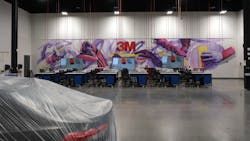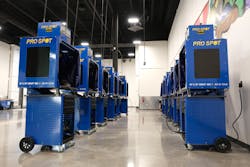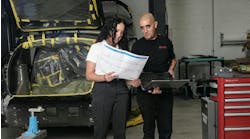Tucked into a business park, 3M has set up a newly constructed collision repair classroom and training center in the company’s hometown of St. Paul, Minnesota.
The 3M Skills Development Center opened its doors to the industry for the first time this summer. The opening was years in the making and started before the COVID-19 pandemic, according to Adam Spah, application engineering manager at 3M.
Spah was the main project manager for the creation of the Skills Development Center. He says that his colleagues were looking ahead at a pending labor drought and saw an opportunity to build a robust, in-person training experience.
“By 2025, there’s going to be a 100,000-technician shortage in the industry,” he says.
3M already had some virtual training programs as part of its Collision Repair Academy. The Skills Development Center is the in-person addition to the company’s suite of training programs.
A Look Inside
The Center is spacious, with a lobby and kitchen area in the front and a big, high-ceiling shop in the back. There are custom murals throughout the facility from local artists, including Adam Turman, Rock ‘CYFI’ Martinez, Biafra, and Wundr.
There’s a classroom setting, equipped with plenty of cameras and display equipment. Some training is best done here, but that’s not where 3M expects much of the time to be spent.
“They learn best by being hands-on and being able to repeat those processes,” says Ben Gervais, senior manager at 3M.
To that end, the shop area is the main event. The space includes a 35-foot paint booth with viewing area, workshop stations with two dozen drops for electrical and air service, a dozen welding stations, and all the equipment needed to work on an on-site test Camry.
As with the classroom, the shop area is equipped with camera systems to record sessions and allow digital viewers if necessary.
The Training Program
A short mantra drives the training ethos at the Skills Development Center.
“Everything we do is around the science of ‘why,’” Spah says.
That means that trainers are expected to be thorough and explain why repair techniques are done a certain way, so trainees understand why some processes might be different from what they’ve done. OEM recommendations and processes are the backbone of those repair techniques, Spah adds.
Training offerings are split into paint/refinish and body programs and run for two to three days at the site. They target professional repairers, especially new techs, but there is also a special segment of training aimed at instructors for other vocational institutions.
Considering rapidly changing vehicle technology, a pending lack of technicians, and a need for standardized training, Gervais says that the the Skills Development Center is filling a crucial gap.
“We believe the need for qualified repair technicians is significant,” he says.
Most of the programming goes toward I-CAR credentials, Gervais adds. Classes began in the summer of 2023, and Spah says that they will work to market those for the time being, though the company will review programming and tweak if necessary.
In the future, Spah says they hope to expand into more training areas, including welding certification.







